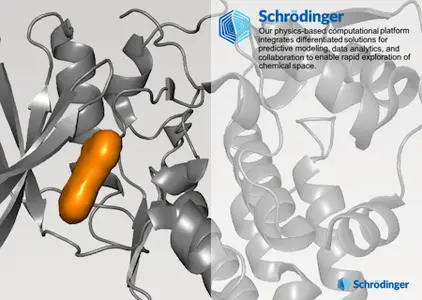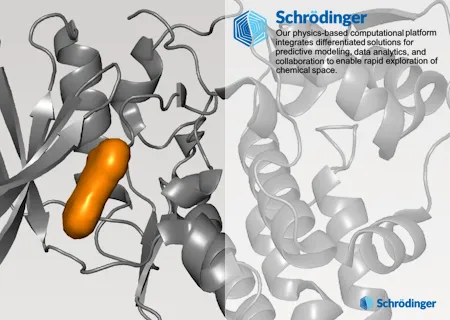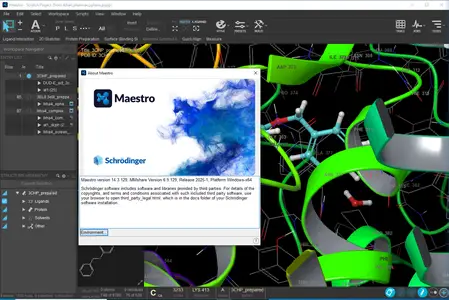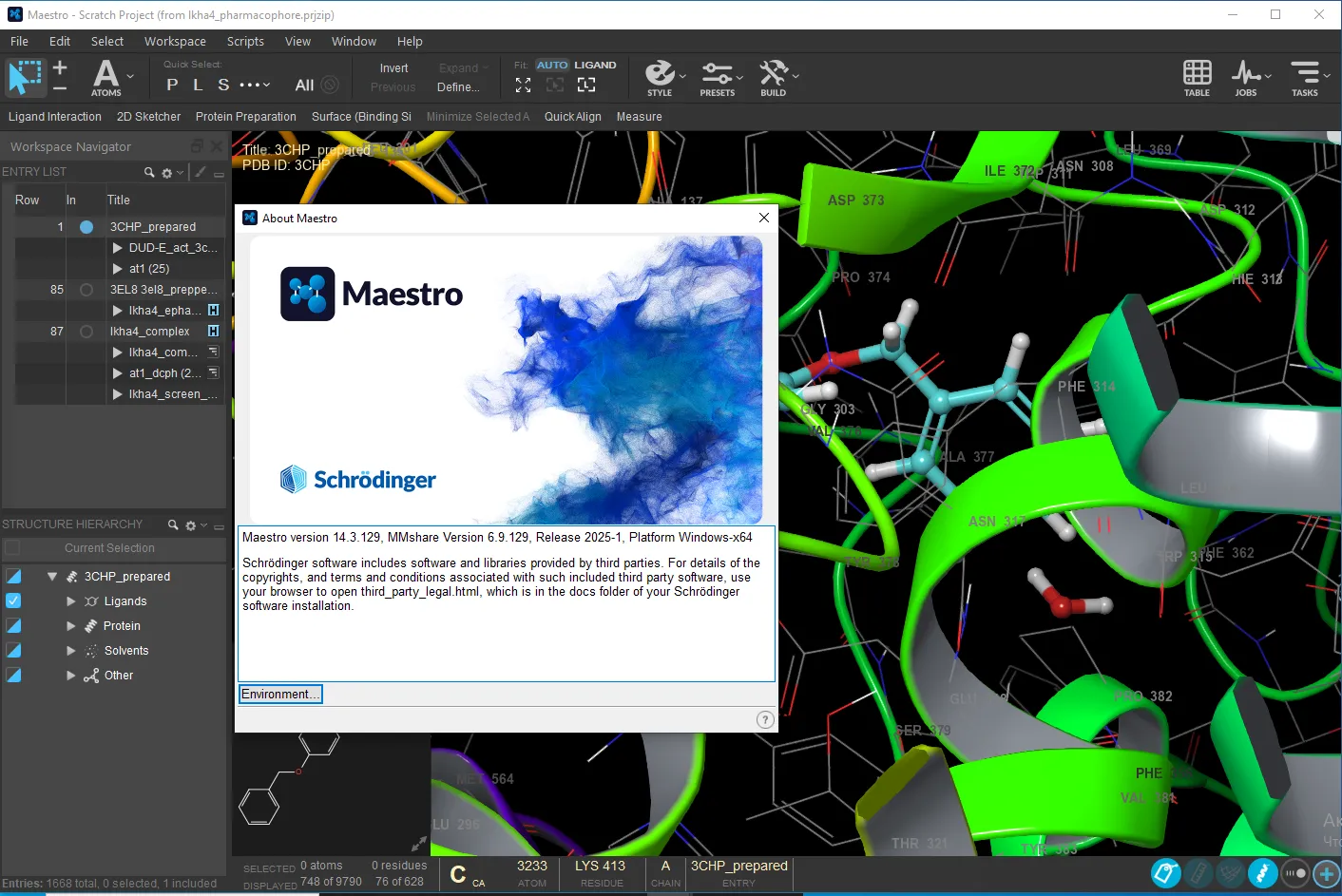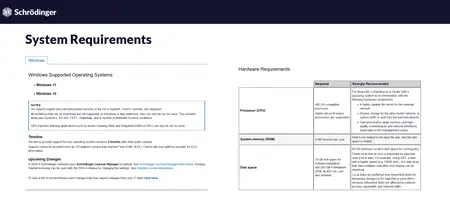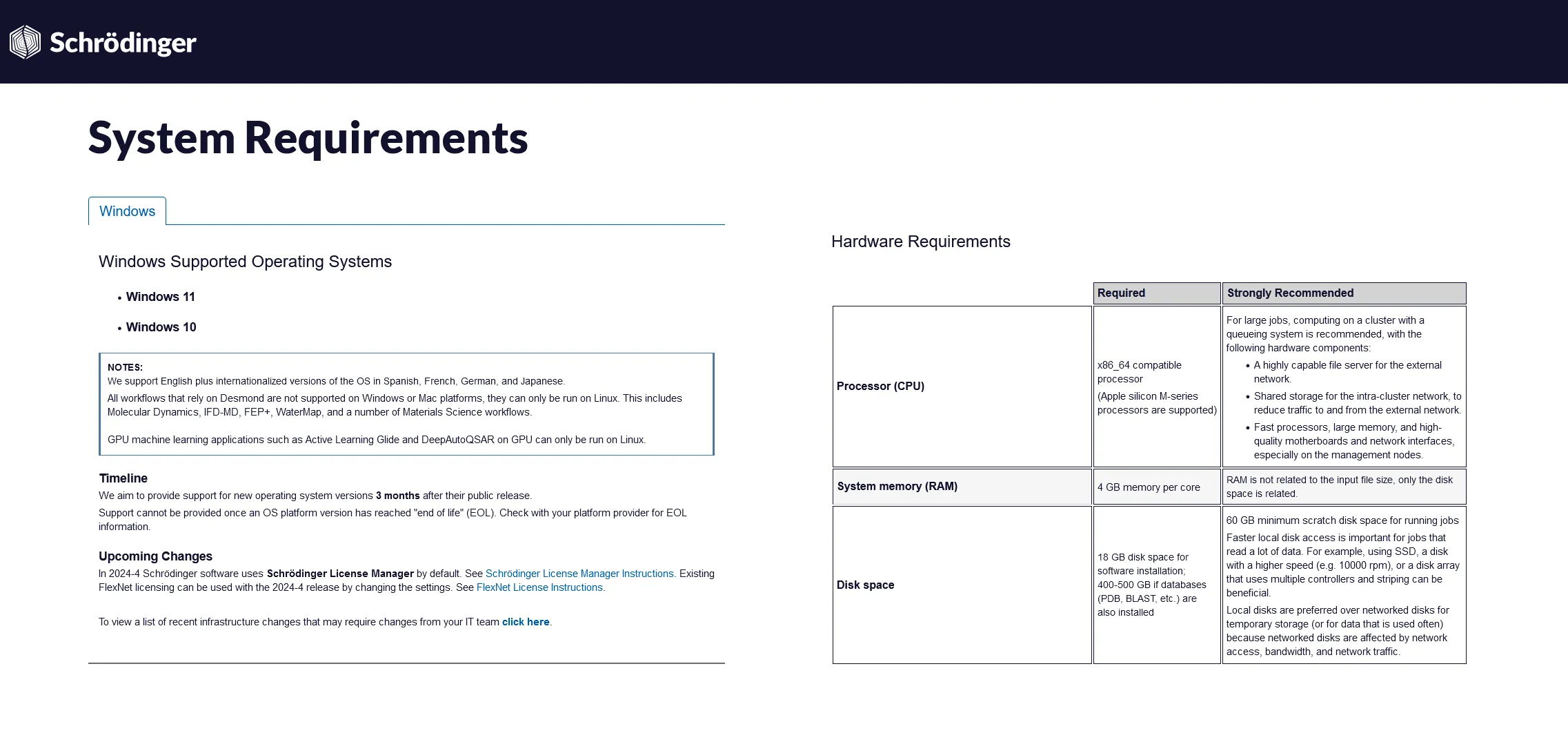Schrodinger Suites 2025-1 | 7.8 Gb
The software developer Schrödinger continuously strive to develop scientific solutions that push the boundaries of molecular design and are delighted to share enhanced drug discovery and materials workflows in Schrödinger’s 2025-1 software release.
Small Molecule Drug Discovery
Target Validation & Structure Enablement
Protein Preparation
- Improved peptide bond connectivity by better integration of sequence information in the Protein Preparation Workflow (PPW)
Protein X-Ray Refinement
- Phenix/OPLS can now run from CIF files containing reflections
Cryo-EM Model Refinement
- Improved support of macrocycles in GlideEM/GlideXtal
Binding Site & Structure Analysis
Binding Site Characterization
- Rationalize kinase selectivity challenges using the Kinase Conservation Analysis Interface that combines sequence and complex structural information: Identify promising selectivity handle residues to modulate ligand kinase selectivity that can be tested with FEP+ Residue Scan
Desmond Molecular Dynamics
- Optimize the unbinding kinetics of protein-ligand complexes using dissolution rate predictions based on unbinding pathways identified by enhanced sampling methods
Mixed Solvent MD (MxMD)
- Identify potential binding sites and assess drugability of competitive and allosteric binding sites with the full release of a Mixed Solvent Molecular Dynamics Interface to setup and analyze MxMD simulations
Hit Identification & Virtual Screening
Active Learning Applications
- Improved diversity of top scoring ligands in Active Learning ABFEP by using 3D features extracted from Glide poses in ML model building
– Researchers can now specify different batch sizes and selection rules to exploit or explore for each iteration in Active Learning simulations
Lead Optimization
Protein FEP
- View trajectories and structural output from FEP+ Residue Scans in the FEP+ interface
- Rationalize key interactions in ligand binding using per-contact residue interaction energy analysis which is new for ABFEP
- Easily identify disconnected sub-maps in a busy FEP map
Spectroscopy
- More accurate NMR spectra predictions by identifying magnetically inequivalent nuclei
Macrocycles
- Automatically enumerate and cyclize peptide sequences from FASTA files with the new cyclize_peptide.py script
- Ring template generation for Glide macrocycle docking with bespoke parameters is now automated by the macrocycle_template_gen.py script
- An updated macrocycle_sample.py script with greater control of sampling options and a new receptor-aware macrocycle sampling algorithm that includes surrounding receptor atoms to restrict conformational search space
. Updated macrocycle_sample.py script replaces macro_sample.py
- Improved handling of ring nitrogen atom substituents during ring template conformation generation
- tug_align.py now supports 2D ligand files as inputs
- tug_align.py exposes several new command-line options that allow finer control of the alignment convergence criteria which are useful in reducing convergence times for large molecules such as cyclic peptides
Medical Chemistry Design
Ligand Designer
- Enable user-specificed or automatically generated ligand protonation and tautomeric states from the 2D/3D editing workflow for MCS Docking
Biologics Drug Discovery
- Completely rewritten MMGBSA Residue Scanning backend that is more reliable and has improved support for a wider variety of non-standard amino acids and mutation of DNA/RNA
- New high-throughput, machine learning-based antibody and nanobody structure prediction with ImmuneBuilder. With throughput of about one minute per structure, it is suitable for batch modeling of thousands of structures
- Automatically identify and annotate for visualization TCR alpha and beta chains from a FASTA file (commandline run_tcr_modeling.py)
- Updated N-glycosylation PROSITE pattern that is less restrictive
Materials Science
GUI for Quantum ESPRESSO
Product: Quantum ESPRESSO (QE) Interface
- Workflow solution to calculate the defect energy
- Workflow action menu (WAM) for output from periodic DFT convergence test
- Support for setting total magnetization/charge for each structure
- Support for computing thermodynamic properties via dynmat.x (command line)
- Support for stopping an NEB calculation and returning intermediate structures
Materials Informatics
Product: MS Informatics
- Formulation ML: Option to control advanced settings
- Machine Learning Property: Skip structures outside the model scope
- Machine Learning Property: Prediction of singlet (S0) to triplet (T1) energy
- Machine Learning Property: Prediction of hole / electron reorganization energy
- Machine Learning Property: Prediction of orbital (HOMO / LUMO) energy
- Machine Learning Property: Updates to existing models
Coarse-Grained (CG) Molecular Dynamics
Product: MS CG
- Automated CG Mapping: Mapping MARTINI for speciality chemicals / polymers
- CG FF Builder: Support for exporting atomistic reference data
Dielectric properties
Product: MS Dielectric
- Complex Permittivity: Linear fitting parameter retained during exponential fitting
Reactivity
Product: MS Reactivity
- Nanoreactor: Control over thermostat bath temperature
- Nanoreactor: Support for parallelization of xTB dynamics simulations
- Reaction Workflow: Support for the use of the xTB Hessian for transition states
- Reaction Workflow: Use of input conformers when conformation search fails
- Reaction Workflow: Improved SCF convergence for energy calculations
Microkinetics
Product: MS Microkinetics
- Microkinetic Modeling: Improved speed/scalability by up to 2 orders of magnitude
- Microkinetic Modeling: Improved model for multiple catalysts / catalyst site types
- Microkinetic Modeling: Improved data visualization in the viewer
- Microkinetic Modeling: Job name shown in the viewer
Reactive Interface Simulator
Product: MS RIS
- Solid Electrolyte Interphase: Improved subjob queuing coordination
- Solid Electrolyte Interphase: Support for constant pressure (NpT) simulations (command-line)
MS Maestro Builders and Tools
- GUI panel to digitally design, manage, and visualize OLED devices
- Single Complex: Improved UI for better usability
- Solvate System: Support for generating multiple configurations by random seeds
Classical Mechanics
- Workflow solution to compute thin plane shear friction
- Barrier Potential for MD: Support for reading barrier information from entry
- Evaporation: Option to plot total number of molecules removed from the system
- Evaporation: Information tied to barriers (when applied) logged in the output
- Polymer Crosslink: Improved speed by efficient checking for ring spears
- Trajectory Density Analysis: Option to display multiple density depths
- Trajectory Density Analysis: Export option for 2D heat-map plot
Quantum Mechanics
- Workflow solution to plot phase diagrams based on energy
- Workflow solution to compute and analyze computational ellipsometry data
- QM Convergence Monitor: Easy access to the structure from the last step
Education Content
Life Science
- New tutorial: Refining crystallographic protein-ligand structures using GlideXtal and Phenix/OPLS
Materials Science
- New tutorial: Automated Martini Fitting for Coarse-Grained Simulations
- New tutorial: Thin Shear
- New tutorial: Defect Energy Calculation
- New tutorial: Optoelectronics Device Designer
- New tutorial: Computational Ellipsometry
- New tutorial: Phase Diagrams
- New tutorial: Ab initio Molecular Dynamics Simulations of Li-ion Diffusion in Solid State Electrolytes
- Updated tutorial: Microkinetic Modeling
- Updated tutorial: Organometallic Complexes
LiveDesign
What’s upcoming in 2025-1
- Extended support for biologics drug discovery: Synchronous selection between Sequence Viewer and 3D Visualizer, support for biologic entities in models which expect atomistic representation, and enhancements for handling non-canonical monomers throughout the application
- Data import performance improvements: Faster small molecule file import and large enumeration result import
- Enhanced formula capabilities: Support multiple value inputs to a formula and align multiple value outputs from a formula by experiment, lot, or pose
Target Validation & Structure Enablement
Protein Preparation
- Improved peptide bond connectivity by better integration of sequence information in the Protein Preparation Workflow (PPW)
Protein X-Ray Refinement
- Phenix/OPLS can now run from CIF files containing reflections
Cryo-EM Model Refinement
- Improved support of macrocycles in GlideEM/GlideXtal
Binding Site & Structure Analysis
Binding Site Characterization
- Rationalize kinase selectivity challenges using the Kinase Conservation Analysis Interface that combines sequence and complex structural information: Identify promising selectivity handle residues to modulate ligand kinase selectivity that can be tested with FEP+ Residue Scan
Desmond Molecular Dynamics
- Optimize the unbinding kinetics of protein-ligand complexes using dissolution rate predictions based on unbinding pathways identified by enhanced sampling methods
Mixed Solvent MD (MxMD)
- Identify potential binding sites and assess drugability of competitive and allosteric binding sites with the full release of a Mixed Solvent Molecular Dynamics Interface to setup and analyze MxMD simulations
Hit Identification & Virtual Screening
Active Learning Applications
- Improved diversity of top scoring ligands in Active Learning ABFEP by using 3D features extracted from Glide poses in ML model building
– Researchers can now specify different batch sizes and selection rules to exploit or explore for each iteration in Active Learning simulations
Lead Optimization
Protein FEP
- View trajectories and structural output from FEP+ Residue Scans in the FEP+ interface
- Rationalize key interactions in ligand binding using per-contact residue interaction energy analysis which is new for ABFEP
- Easily identify disconnected sub-maps in a busy FEP map
Spectroscopy
- More accurate NMR spectra predictions by identifying magnetically inequivalent nuclei
Macrocycles
- Automatically enumerate and cyclize peptide sequences from FASTA files with the new cyclize_peptide.py script
- Ring template generation for Glide macrocycle docking with bespoke parameters is now automated by the macrocycle_template_gen.py script
- An updated macrocycle_sample.py script with greater control of sampling options and a new receptor-aware macrocycle sampling algorithm that includes surrounding receptor atoms to restrict conformational search space
. Updated macrocycle_sample.py script replaces macro_sample.py
- Improved handling of ring nitrogen atom substituents during ring template conformation generation
- tug_align.py now supports 2D ligand files as inputs
- tug_align.py exposes several new command-line options that allow finer control of the alignment convergence criteria which are useful in reducing convergence times for large molecules such as cyclic peptides
Medical Chemistry Design
Ligand Designer
- Enable user-specificed or automatically generated ligand protonation and tautomeric states from the 2D/3D editing workflow for MCS Docking
Biologics Drug Discovery
- Completely rewritten MMGBSA Residue Scanning backend that is more reliable and has improved support for a wider variety of non-standard amino acids and mutation of DNA/RNA
- New high-throughput, machine learning-based antibody and nanobody structure prediction with ImmuneBuilder. With throughput of about one minute per structure, it is suitable for batch modeling of thousands of structures
- Automatically identify and annotate for visualization TCR alpha and beta chains from a FASTA file (commandline run_tcr_modeling.py)
- Updated N-glycosylation PROSITE pattern that is less restrictive
Materials Science
GUI for Quantum ESPRESSO
Product: Quantum ESPRESSO (QE) Interface
- Workflow solution to calculate the defect energy
- Workflow action menu (WAM) for output from periodic DFT convergence test
- Support for setting total magnetization/charge for each structure
- Support for computing thermodynamic properties via dynmat.x (command line)
- Support for stopping an NEB calculation and returning intermediate structures
Materials Informatics
Product: MS Informatics
- Formulation ML: Option to control advanced settings
- Machine Learning Property: Skip structures outside the model scope
- Machine Learning Property: Prediction of singlet (S0) to triplet (T1) energy
- Machine Learning Property: Prediction of hole / electron reorganization energy
- Machine Learning Property: Prediction of orbital (HOMO / LUMO) energy
- Machine Learning Property: Updates to existing models
Coarse-Grained (CG) Molecular Dynamics
Product: MS CG
- Automated CG Mapping: Mapping MARTINI for speciality chemicals / polymers
- CG FF Builder: Support for exporting atomistic reference data
Dielectric properties
Product: MS Dielectric
- Complex Permittivity: Linear fitting parameter retained during exponential fitting
Reactivity
Product: MS Reactivity
- Nanoreactor: Control over thermostat bath temperature
- Nanoreactor: Support for parallelization of xTB dynamics simulations
- Reaction Workflow: Support for the use of the xTB Hessian for transition states
- Reaction Workflow: Use of input conformers when conformation search fails
- Reaction Workflow: Improved SCF convergence for energy calculations
Microkinetics
Product: MS Microkinetics
- Microkinetic Modeling: Improved speed/scalability by up to 2 orders of magnitude
- Microkinetic Modeling: Improved model for multiple catalysts / catalyst site types
- Microkinetic Modeling: Improved data visualization in the viewer
- Microkinetic Modeling: Job name shown in the viewer
Reactive Interface Simulator
Product: MS RIS
- Solid Electrolyte Interphase: Improved subjob queuing coordination
- Solid Electrolyte Interphase: Support for constant pressure (NpT) simulations (command-line)
MS Maestro Builders and Tools
- GUI panel to digitally design, manage, and visualize OLED devices
- Single Complex: Improved UI for better usability
- Solvate System: Support for generating multiple configurations by random seeds
Classical Mechanics
- Workflow solution to compute thin plane shear friction
- Barrier Potential for MD: Support for reading barrier information from entry
- Evaporation: Option to plot total number of molecules removed from the system
- Evaporation: Information tied to barriers (when applied) logged in the output
- Polymer Crosslink: Improved speed by efficient checking for ring spears
- Trajectory Density Analysis: Option to display multiple density depths
- Trajectory Density Analysis: Export option for 2D heat-map plot
Quantum Mechanics
- Workflow solution to plot phase diagrams based on energy
- Workflow solution to compute and analyze computational ellipsometry data
- QM Convergence Monitor: Easy access to the structure from the last step
Education Content
Life Science
- New tutorial: Refining crystallographic protein-ligand structures using GlideXtal and Phenix/OPLS
Materials Science
- New tutorial: Automated Martini Fitting for Coarse-Grained Simulations
- New tutorial: Thin Shear
- New tutorial: Defect Energy Calculation
- New tutorial: Optoelectronics Device Designer
- New tutorial: Computational Ellipsometry
- New tutorial: Phase Diagrams
- New tutorial: Ab initio Molecular Dynamics Simulations of Li-ion Diffusion in Solid State Electrolytes
- Updated tutorial: Microkinetic Modeling
- Updated tutorial: Organometallic Complexes
LiveDesign
What’s upcoming in 2025-1
- Extended support for biologics drug discovery: Synchronous selection between Sequence Viewer and 3D Visualizer, support for biologic entities in models which expect atomistic representation, and enhancements for handling non-canonical monomers throughout the application
- Data import performance improvements: Faster small molecule file import and large enumeration result import
- Enhanced formula capabilities: Support multiple value inputs to a formula and align multiple value outputs from a formula by experiment, lot, or pose
Schrödinger Software provide accurate, reliable, and high performance computational technology to solve real-world problems in life science research. It can be used to build, edit, run and analyse molecules. The Schrödinger-Suite of applications have a graphical user interface called Maestro. Using the Maestro you can prepare your structure for refinement. The following products are available: CombiClide, ConfGen, Core Hopping, Desmond, Epik, Glide, Glide, Impact, Jaguar ( high-performance ab initio package), Liaison, LigPrep, MacroModel, MCPRO+, Phase, Prime, PrimeX, QikProp, QSite, Semi-Empirical, SiteMap, and Strike.
Schrödinger Release - New Features 2025-1
Schrödinger, LLC provides scientific software solutions and services for life sciences and materials research, as well as academic, government, and non-profit institutions around the world. It offers small-molecule drug discovery, biologics, materials science, and discovery informatics solutions; and PyMOL, a 3D molecular visualization solution. The company was founded in 1990 and is based in Portland, Oregon with operations in the United States, Europe, Japan, and India.
Owner: Schrödinger, LLC
Product Name: Schrödinger Suites
Version: 2025-1 Commercial Version
Supported Architectures: x64
Website Home Page : www.schrodinger.com
Languages Supported: english
System Requirements: Windows *
Size: 7.8 Gb
Please visit my blog
Added by 3% of the overall size of the archive of information for the restoration
No mirrors please
Added by 3% of the overall size of the archive of information for the restoration
No mirrors please


